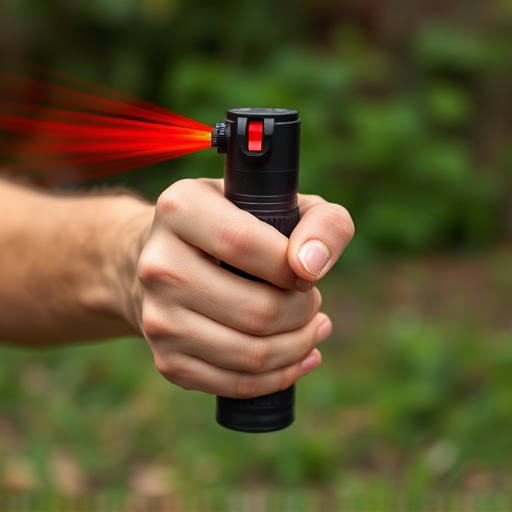Defensive pepper spray utilizes capsaicin from chili peppers to temporarily disable attackers by targeting their eyes, nose, and respiratory system within a crucial defensive pepper spray distance range of 2-3 meters (6-10 feet). This safe, non-lethal tool enhances personal protection, allowing users to create space, react, or deploy other defenses during dangerous situations. Choosing a durable device with easy activation mechanisms and clear labels ensures reliability and effectiveness in close encounters.
“Personal safety is paramount, and with the growing demand for effective self-defense solutions, capsaicin-based personal protection devices are making headlines. This article explores the power of capsaicin as an active ingredient in defensive pepper spray, shedding light on its mechanism of action and proven effectiveness. We’ll navigate the key features to look for in these devices, from durable construction to easy application. Additionally, we’ll delve into the impressive defensive pepper spray distance range, empowering you with knowledge to make informed choices for your safety.”
- Understanding Capsaicin: The Active Ingredient in Pepper Spray
- How Defensive Pepper Spray Works and Its Effectiveness
- Key Features to Consider in a Capsaicin-Based Personal Protection Device
- The Range of Pepper Spray: A Comprehensive Look at Distance and Effect
Understanding Capsaicin: The Active Ingredient in Pepper Spray
Capsaicin, the active ingredient in pepper spray, is a natural compound derived from chili peppers. It’s what gives spicy foods their heat and sting. When used in defensive pepper spray, capsaicin irritates the eyes, nose, and respiratory system of an attacker, creating a temporary but potent defense. The effective defensive pepper spray distance range varies based on factors like concentration and application method, but it generally starts to take effect at close range, often within 2-3 meters (6-10 feet).
This compound disrupts the communication between nerve cells, leading to painful sensations and a strong irritation response. Unlike other irritants, capsaicin specifically targets the vanilloid receptors in the body, which are responsible for sensing heat and pain. This targeted action ensures that pepper spray remains a safe, non-lethal option for self-defense while effectively deterring and disabling attackers.
How Defensive Pepper Spray Works and Its Effectiveness
Defensive pepper spray is a powerful personal protection tool designed to incapacitate an assailant temporarily, giving the user precious time to escape or defend themselves. It works by targeting the body’s sensory system, specifically the eyes and respiratory tract. Capsaicin, the active ingredient in pepper spray, is derived from chili peppers and is known for its irritant properties. When sprayed, capsaicin comes into contact with these sensitive areas, causing a burning sensation and temporary blindness. This disorientates and disrupts an attacker’s ability to continue the assault.
The effectiveness of defensive pepper spray lies in its ability to create a safe distance between the user and their assailant. The recommended defensive pepper spray distance range is typically around 2-3 meters (6-10 feet), allowing users to activate the spray from a safe distance while maintaining mobility. This range gives users time to react, retreat, or deploy other self-defense measures. Studies have shown that when used correctly, pepper spray can increase survival rates and reduce injury during potentially life-threatening situations.
Key Features to Consider in a Capsaicin-Based Personal Protection Device
When considering a Capsaicin-based personal protection device, several key features determine its effectiveness and usability. Firstly, the defensive pepper spray distance range is crucial. Look for devices that can spray at a distance suitable for self-defense, typically between 2 to 4 meters (6 to 13 feet), ensuring you have enough space to retreat or disable an attacker.
Additionally, consider factors like ease of use, especially in stressful situations. A simple, one-handed activation mechanism is ideal. Durability and reliability are also essential; the device should withstand various environmental conditions, including temperature extremes and water exposure, to guarantee its longevity. Moreover, check for a clear, concise warning label that communicates the active ingredient and potential effects, helping to deter potential aggressors.
The Range of Pepper Spray: A Comprehensive Look at Distance and Effect
Pepper spray, a common personal protection device, has become an essential tool for self-defense. When it comes to understanding its effectiveness, one crucial factor is the defensive pepper spray distance range. This range refers to the proximity at which the spray can be deployed to neutralize or deter an attacker. Typically, pepper spray has a working distance of 2–3 meters (6–10 feet), making it highly effective for close-quarters encounters.
The distance at which pepper spray is most potent varies based on factors like the user’s accuracy, wind conditions, and the specific type of spray. In optimal conditions, a well-aimed burst can temporarily incapacitate an aggressor from as far as 3 meters away. This range ensures users have a strategic advantage in close encounters, allowing them to create space and escape potentially dangerous situations.
Capsaicin-based personal protection devices, including pepper spray, offer an effective deterrent for self-defense. Understanding the active ingredient’s mechanisms and the device’s key features is essential when considering its range and effectiveness. The defensive pepper spray distance range varies, but with proper usage, it can neutralise threats at close to medium ranges. By equipping yourself with knowledge and the right tools, individuals can enhance their personal safety and navigate potential dangers confidently.
